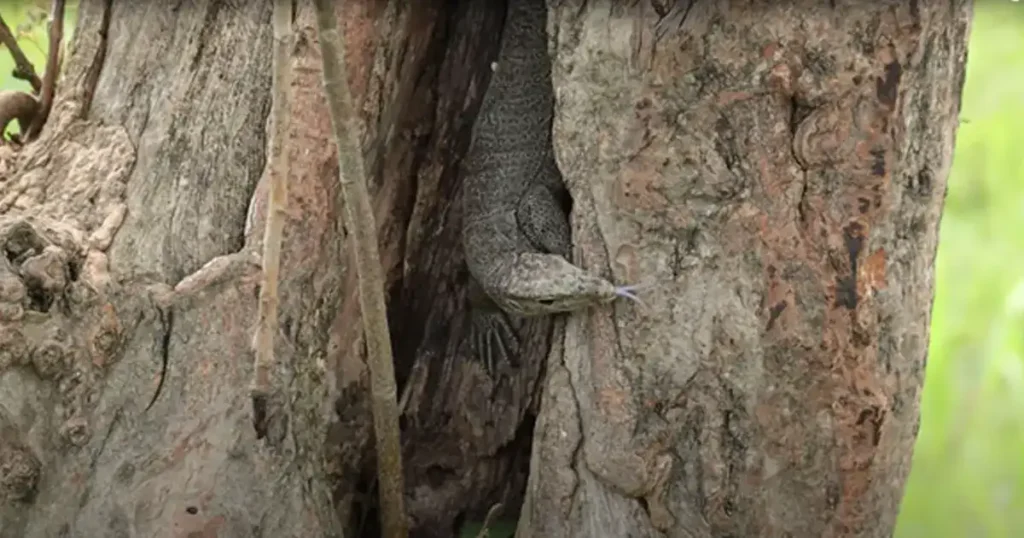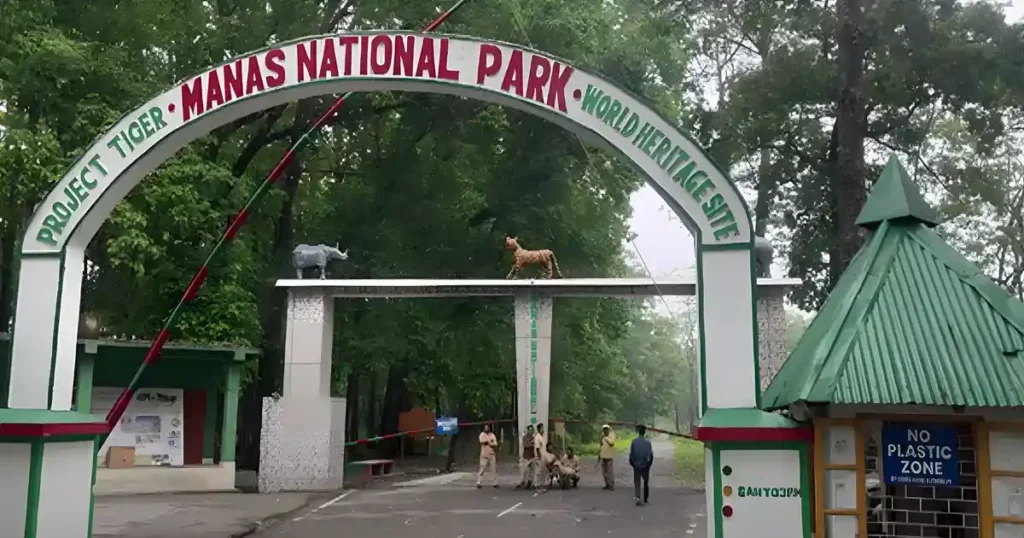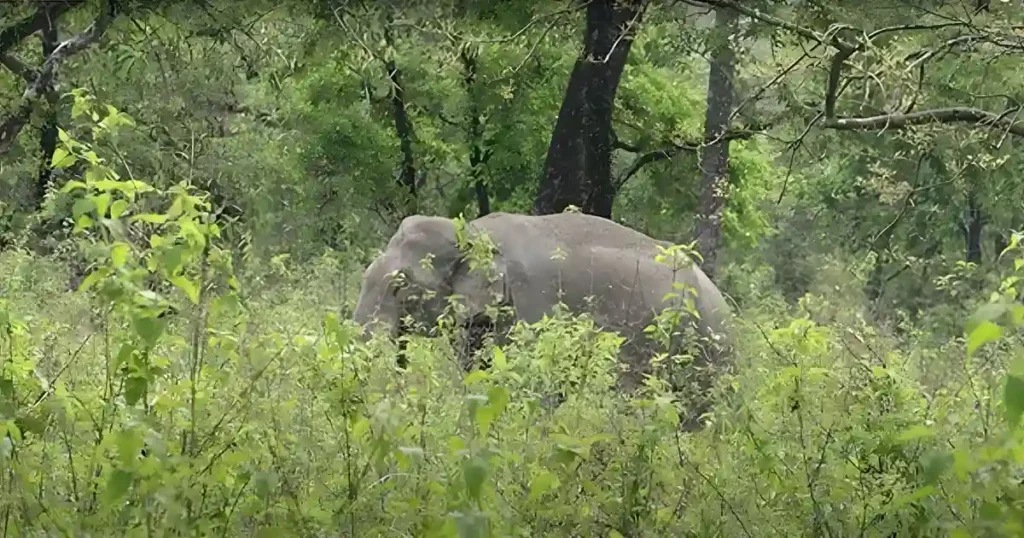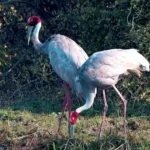Spread over an area of 850 sq. km with dense forests, grasslands, and wetlands, Manas National Park in Assam, India, is a UNESCO World Heritage Site, a Project Tiger reserve, and an elephant reserve. The park shares a transboundary international border with Bhutan’s Royal Manas National Park and derives its name from the Manas River. The Manas River flows through the park and joins the Brahmaputra River. Manas National Park is famous for its biodiversity inhabiting endangered species like the Assam roofed turtle, hispid hare, golden langur, pygmy hog, and wild water buffalo.
Established as a sanctuary in 1928, Manas National Park underwent expansions and was declared a World Heritage Site in 1985. However, due to poaching and other issues, UNESCO labelled it a site in danger in 1992. Later, UNESCO removed it from the danger list in 2011 due to its conservation efforts. Its geography spans the Chirang and Baksa districts with rich forested areas fed by multiple rivers. There are as many as 60 species of mammals, 312 birds, 42 reptiles, 7 amphibians, 54 fishes, and more than 100 species of insects in the park.
Manas National Park is located in which state
Manas National Park is located in the districts of Chirang and Baksa under the Bodoland Territorial Region (BTR) in Assam, Northeastern India. It is situated at an elevation ranging from 61 to 110 meters (200 to 361 feet) above sea level. The geographical coordinates of the park are latitude 26°43’N to 26°717’N, and longitude 90°56’E to 90°9.93’E. The park is located 145 kilometers from Guwahati.
Area, Location and Ranges
• Park Area: 850 Sq. Kms
• Location: Located in Chirang and Baksa district under BTR in Western Assam, India.
• Latitude: 26°43N -26°717N
• Longitude: 90°56N-90°9.93E
• Park Ranges: 1. Panbari Range (Western), 2. Bansbari Range (Central), 3. Bhuyanpara Range (Eastern), 4. Kuklung Range (1st Addition)
• Climate: Tropical (10-37 degree Celsius)
• Rainfall: 3000 mm
Manas National Park location google map
Manas National Park in India Map
The map of Manas National Park clearly shows its international boundary with Bhutan to the north. Manas National Park shares a transboundary area with Royal Manas National Park in Bhutan, which spans 1,059 square kilometers. The southern part of Manas National Park is marked by 136 densely populated villages, with a 3 km buffer zone. The western boundary of the park is marked by Manas Reserve Forest, and the eastern boundary is marked by the Daodhora Reserve Forest.
The Manas National Park spans an area of 500 square kilometers and is the main part of the Manas Tiger Reserve, which covers 2,837 square kilometers. This reserve is like a long strip of forests running along the foothills from the Sankosh River in the west to the Dhansiri River in the east.

Manas National Park Famous for
Manas National Park is famous for its rare and endangered endemic wildlife, such as tigers, Indian rhinoceroses, hispid hare, golden langur, Assam roofed turtle, elephants, and pygmy hog. It is designated as a UNESCO World Heritage Site, a Project Tiger reserve, an elephant reserve, and a Biosphere Reserve. The park is also renowned for its sizable population of wild water buffalo.
Manas National Park History
The Manas National Park has a long history of conservation and protection spanning over 110 years. During this time, it has received various special titles and recognition for its conservation efforts.
- In 1905, it was called the North Kamrup Reserve Forest.
- In 1907, it was Manas Reserve Forest.
- On October 1, 1928, it was declared as Manas Wildlife Sanctuary, covering 360 sq. km.
- In 1951 and 1955, the area of Manas Wildlife Sanctuary was increased to 391 km² (151 sq mi).
- In 1973, it was declared as Manas Tiger Reserve, covering an area of 2,837 sq. km.
- In December 1985, it was declared a World Heritage Site by UNESCO.
- In 1989, it was established as a Biosphere Reserve through a Government of India notification vide No. 16/2/84-CSC dated March 14, 1989.
- In 1990, it was declared as Manas National Park, covering an area of 500 sq. km.
- In 1992, UNESCO declared it a World Heritage Site in Danger due to poaching and other issues, including terrorist activities.
- In 2003, it was declared as the Chirang-Ripu Elephant Reserve, covering 2,600 sq. km, through Government notification No.FRW-44/2002/47 dated March 6, 2003.
- In 2004, it was designated as an Important Bird Area.
- On June 21, 2011, it was removed from the List of World Heritage in Danger by UNESCO.
- In 2017, the area of Manas National Park was extended from 500 sq. km to 850 sq. km.

Manas National Park: Geography & Climate
1. Geography:
The physical geography of Manas National Park is densely forested. The Manas River, a major Brahmaputra tributary, flows through the west of the park. As it reaches the plains, it splits into two separate rivers, Bwrsi and Bholkaduba. Five smaller rivers also flow through the park’s wide and plain area below the outer Himalayan hills.
The northern part of the park has limestone and sandstone under the savanna, while the south has deep alluvial soil under the grasslands. This blend of landscapes, along with the river, makes it one of the world’s most biologically diverse areas.
The forest in Manas National Park is classified as Eastern wet alluvial grassland, categorized as the Phragmites-Saccharum-Imperata type. Other forest types include Sub-Himalayan high alluvial Semi-evergreen, Eastern Himalayan Moist Mixed Deciduous, and Assam valley Semi-evergreen. Additionally, there is a considerable variety of aquatic flora along the riverbanks and in pools.
2. Climate:
Manas National Park experiences a subtropical climate with varying temperatures. Minimum temperatures soar to around 15°C, while maximums reach 37°C. The park’s distinct seasons offer a comfortable environment for visitors and wildlife.
Heavy rainfall from May to September, with an annual average of 333 centimeters (131 inches), sustains the lush ecosystem. The monsoon transforms the park into a lively, green paradise.

Manas National Park: A Biodiversity Hotspot
Manas National Park is recognized as a Biosphere Reserve due to its special ecological importance and rich biological variability of flora and fauna.
1. Two Major Biomes
There are two main types of environments or biomes in Manas National Park: grassland and forest. The grassland biome is home to animals like the Indian rhinoceros, pygmy hog, wild Asian buffalo, and Bengal florican. The forest biome is where you can find animals like wild pigs, slow loris, Chinese pangolins, and hornbills.
2. Diverse Flora
Manas National Park, located in the Brahmaputra Valley, boasts a rich variety of vegetation. It encompasses:
a) Sub-Himalayan light alluvial semi-evergreen forests in the north.
b) East Himalayan mixed moist and dry deciduous forests (the most common).
c) Low alluvial savanna woodland.
d) Assam Valley semi-evergreen alluvial grasslands (covering about 50% of the park).
The park’s plant life consists of 543 species, including 374 dicotyledons (including 89 trees), 139 monocotyledons, and 30 pteridophytes and gymnosperms. Common trees in the park include Aphanamixis polystachya, Anthocephalus chinensis, various Syzygium species, Bauhinia purpurea, and many others. The grasslands are dominated by plants such as Imperata cylindrica, Saccharum naranga, and Phragmites karka.
3. Abundant Fauna
Manas National Park is teeming with wildlife. There are 55 different mammal species, 380 bird species, 50 reptile species, and 3 amphibian species living here. Impressively, 21 of these mammals are India’s Schedule-I species, and 31 of them are in danger of disappearing. The sanctuary is home to various wildlife, including Indian elephants, rhinoceroses, tigers, golden langurs, leopards, and a range of other animals, including rare ones like the Assam roofed turtle and pygmy hog.
4. Avifauna
Manas National Park has the largest population of Bengal florican. Common bird species found in the park include great hornbills, pied hornbills, grey hornbills, jungle fowls, bulbuls, brahminy ducks, kalij pheasants, egrets, pelicans, fishing eagles, crested serpent-eagles, falcons, scarlet minivets, Indian peafowl, ospreys, bee-eaters, magpie robins, mergansers, harriers, and herons.

Things to do at Manas National Park
Manas National Park offers many activities for visitors who want to explore and enjoy nature. If you’re interested, take a look to find out what you can do at Manas National Park
1. Jeep Safari
Manas National Park is home to over 31 rare and endangered species of birds and animals. During a Jeep Safari through the park, you can spot unique creatures like the Assam roofed turtle, pygmy hog, and hispid hare. The park’s scenic natural environment will fill you with a deep appreciation for nature.
Price: INR 3600 per jeep
Timings: 09:00 am to 12:00 pm and 02:00 pm to 05:00 pm.
2. Elephant Safari
Embarking on an Elephant Safari, riding on the back of an elephant through Manas National Park, is another exciting adventure to spot animals. These magnificent animals are an integral part of the park, and riding on them allows you to explore areas that are not accessible to jeeps. It provides a unique perspective of the park from the back of an elephant.
Price: INR 500 for Indians, INR 1,550 for foreigners.
Timings: 6:00 to 7:00 AM
3. River Rafting
River rafting on the calm waters of the Manas River is an exhilarating experience. The 35-kilometer ride takes you through the park’s dense deciduous forests, which are home to 400 different species of birds. Rafting on the deep blue waters of the river is an experience you should definitely look forward to.
Price: Check the pricing with private tour operators there.
Timings: 8:00 am to 4:00 pm.
4. Tea Plantations Visit
Assam is famous for its tea plantations, and there are plenty of tea gardens just south of the park. Take a break at Fatemabad Tea Estate, next to Bansbari Lodge, for a pleasant walk through their beautiful estate.
Price: Not applicable. Timings: 8:00 am to 6:00 pm.
5. Manas National Park photos
Explore the mesmerizing beauty of Manas National Park with amazing photos. See lush forests, rare animals, and peaceful landscapes. These pictures show you the park’s different parts and amazing views. They’re a special delight for people who love nature and travel.

Best Time to Visit the Manas National Park
The best time to visit Manas National Park is from November to April. During this period, the weather is pleasant, and there’s a higher chance of spotting wildlife. The park is open every day during these six months, except in exceptional circumstances like heavy rain or safety concerns. It’s important to note that the park is partially open in May and October. However, due to the monsoon season from June to September, the park remains closed.
How To Reach the Manas National Park
1. By Air:
The Lokpriya Gopinath Bordoloi International Airport (LGBIA) in Guwahati is the nearest airport to Manas National Park, located 180 km away. Regular flights are available from major cities such as New Delhi, Mumbai, and Bangalore. To reach the park, you can take a private taxi from the airport.
2. By Rail:
The nearest railway station to Manas National Park is Barpeta railway station, which is located 22 km away. The distance from Guwahati railway station to Barpeta railway station is 130 km.
3. By Road:
Manas National Park is located 176 km from Guwahati, which takes approximately 5 hours by road. NH27 connects Barpeta Road to Bansbari, which is around 22 km from the entry point of Manas National Park. You can navigate through Google Maps for a better reference of Manas National Park’s location.
Manas National Park Safari Zones & Timing
| Manas Safari Zone & Slots | Manas Safari Price & Timing |
| Jeep Price (Indian) | Bansbari Zone – 4300 / Jeep | Bhuyanpara Zone – 5300/ Jeep (for 5 persons) |
| Jeep Price (Foreigner) | Bansbari Zone – 8000 / Jeep | Bhuyanpara Zone – 9000/ Jeep (for 5 persons) |
| Jeep Safari Timings | 06:30 – 9:30 | 10:00 AM – 1:00 PM | 02:00 PM – 5:00 PM |
| The price includes: Jeep & Driver, Permit Charges, Online Payment Gateway Charges & Our Service Charges and Taxes. | |
| Elephant Price (Indian) | Bansbari Zone INR 1350 / Person (1 Hour) |
| Elephant Price (Foreigner) | Bansbari Zone INR 3200 / 1 Person (1 Hour) |
| Elephant Safari Timings | 06:00 AM – 7:00 AM | 7:00 AM – 8:00 AM |
| Booking Amount | Safari booking amount will not refundable |
| Jeep safari is non-sharing, with children under 4 free and those 4 and above considered adults. Jeep safari duration is 3 hours while Elephant safari is 1 hour. | |
| Booking in advance is recommended due to limited availability of safaris and guides during peak tourism seasons | |

Where to Stay at Manas National Park
Hotels at Manas National Park are limited, but comfortable lodges provide a hotel-like experience. If you’re wondering about the cost of a safari at Manas National Park, rest assured that these accommodations can also arrange safaris.
1. Birina Tourist Lodge
Birina Cottages are situated adjacent to a tea estate, providing a delightful place to stay. They offer clean and comfortable cottage rooms equipped with essential amenities. This place is an excellent choice for both honeymooners and families. Additionally, they offer various activities such as jungle safaris, river rafting, and open-air theatre.
2. Florican Cottages
Florican Cottages, managed by an NGO, provide comfortable Assamese thatched cottages for your stay. They offer various activities such as jungle rides, bird-watching treks, and cultural experiences.
3. Musa Jungle Retreat
The only resort in the region that provides a 5-star accommodation experience is Musa Jungle Retreat. Three types of cottages offer various experiences and views. The resort also features its own restaurant serving Indian, Continental, Bodo, and Chinese cuisine. Activities include jungle safaris, river rafting, village trails, and picnics.
4. Sikhiri Cottages
Sikhiri Cottages provide sheer privacy and a tranquil ambiance situated in proximity to Manas National Park. This accommodation offers paradisiacal natural environs and a serene riverfront view with scenic surroundings. They also provide various activities such as jeep safaris, river rafting, and elephant safaris.
5. Smiling Tusker Elephant Camp
Nestled within lush tea gardens, the Smiling Tusker Elephant Camp offers exciting activities like elephant rides and river rafting. They provide a peaceful and comfortable stay while also focusing on rehabilitating domesticated elephants. Activities include river rafting, elephant rides, and jeep safaris.
6.Forest Lodges
There is a Forest Lodge situated at Mathanguri inside the park which is 40 km from Barpeta Road. Visitors can obtain the necessary permission for entry into the park at the office of the Field Director of Manas Tiger Reserve, Barpeta Road.
Conclusion
Manas National Park is a sanctuary and UNESCO World Heritage Site, as well as a Project Tiger reserve, elephant reserve, and Biosphere Reserve. It spans 850 square kilometers of dense forests, grasslands, and wetlands, sharing a transboundary connection with Bhutan’s Royal Manas National Park. Despite facing challenges such as poaching, the park has succeeded in conserving its flora and fauna. Visitors can explore this natural wonder through Jeep Safari, Elephant Safari, and River Rafting, staying in comfortable lodges nearby.
FAQ
a.) What is Manas National Park famous for?
Manas National Park is famous for its rare and endangered endemic wildlife such as tigers, Indian rhinoceroses, hispid hare, golden langur,roofed turtle, elephants and pygmy hog. It is a place of UNESCO World Heritage Site, Project Tiger reserve, elephant reserve and Biosphere Reserve.
b.) In which district of Assam is Manas National Park?
Manas National Park is located in the district of Chirang and Baksa under Bodoland Territorial Region (BTR) in Assam of North-eastern India. It is at an elevation of above sea mean level 61–110 metres (200–361ft). The geographical co-ordination of the park is latitude 26°43N -26°717N, Longitude 90°56N-90°9.93E. The park is 145km from Guwahati
c.) Manas national Park UPSC?
Manas National Park has a long history conservation and protection over 110 years. It began as the North Kamrup Reserve Forest in 1905, evolving into the Manas Wildlife Sanctuary in 1928. It was notified as the Manas Tiger Reserve in 1973. Recognised by UNESCO as World Heritage Site status in 1985 and Biosphere Reserve recognition in 1989. In 1990, it was declared as Manas National Park. In 2011 it was removed from the World Heritage in Danger list. In 2017 its boundaries expanded across 850 square kilometers.
You May Also Like
- Chakrashila Wildlife Sanctuary
- Sonai Rupai Wildlife Sanctuary
- Bornadi Wildlife Sanctuary
- Nameri National Park
- Bura Chapori Wildlife Ssanctuary










2 thoughts on “Manas National Park”